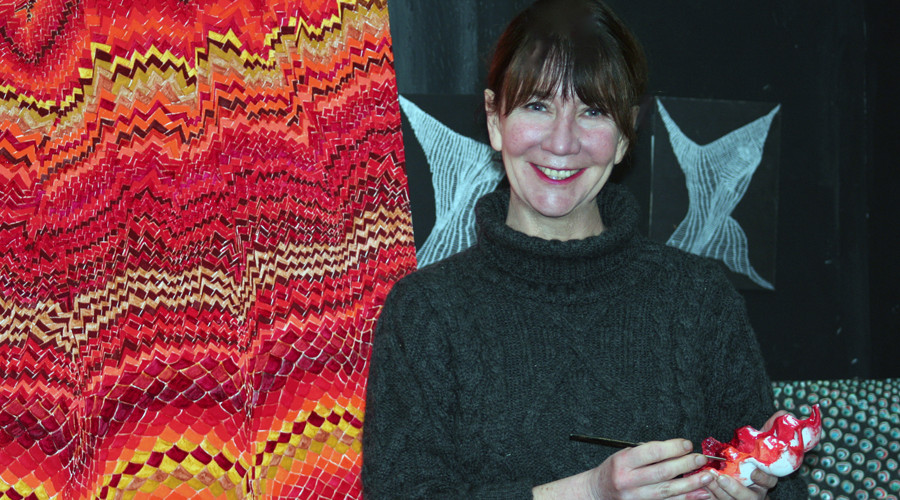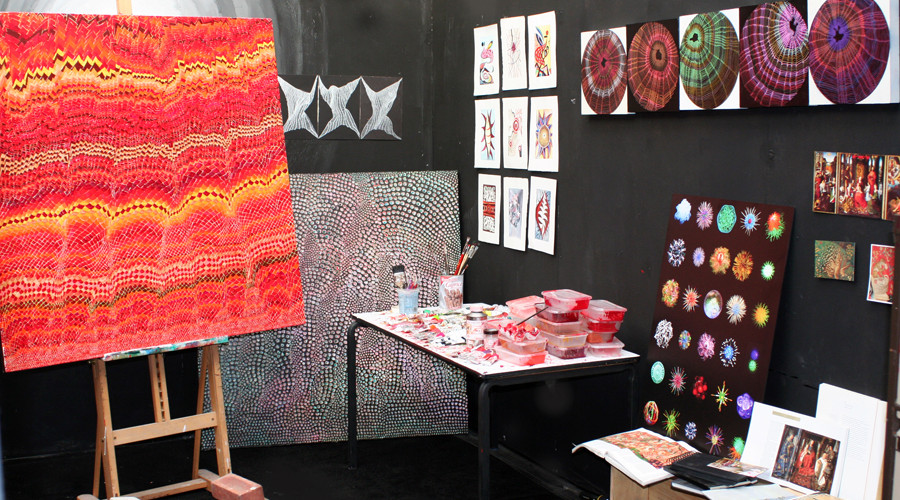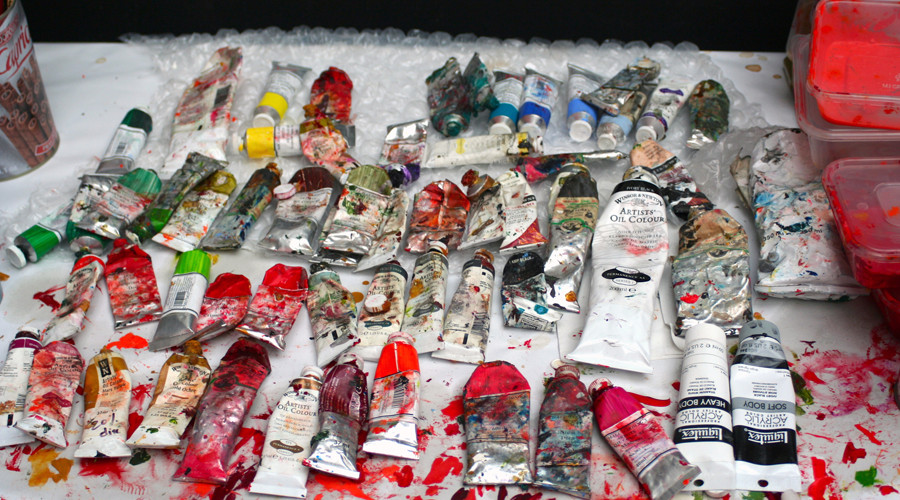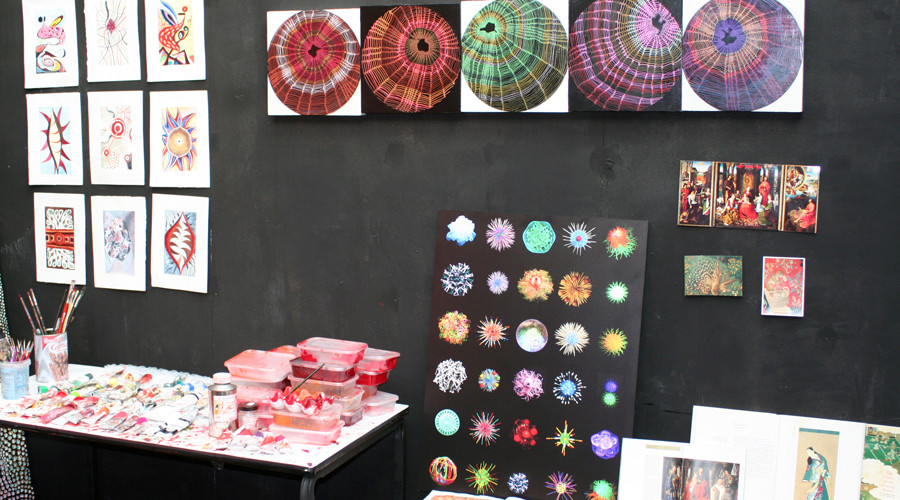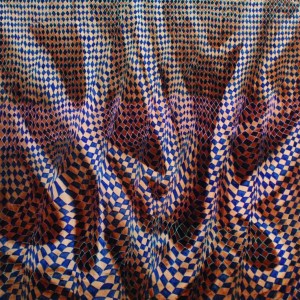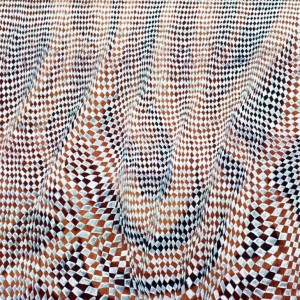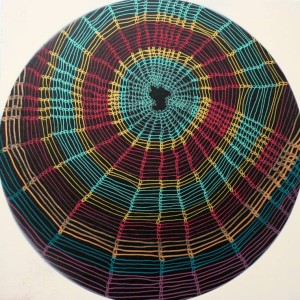Inside the Studio
 Sara Willett
Sara Willett
Favorite material to work with?
I work with a variety of paints and other materials, whatever happens to be right for what I’m doing. In the end I do love oil, the smell, the texture and the glow. Michael Harding oils are a dream to work with.
What themes do you pursue?
I guess I have always been drawn to the decorative, but because it is so often used as a pejorative term, I started to think about its position in contemporary art and how it could be employed without appearing twee. The capacity for the decorative to act as a disruptive or disturbing force is something that fascinates me. The way that female artists or those outside the mainstream started to use decorative elements in their work to provoke and undermine the status quo in the late 20th century was probably my starting point.
How many years as an artist?
11 years practicing with a studio.
Where is your studio?
My studio is in The Lewisham Arthouse in South East London, an artists’ collective, housed in a beautiful old Edwardian Library. The library was closed in the 90’s and started to go to rack and ruin, before a bunch of artists moved in. We run as a co-operative; all money from studio rents are ploughed back into running the building, a gallery, an education programme, and a workspace for experimental music, film, and other creative work.
What was the best advice given to you as an artist?
Don’t be afraid to make mistakes – that’s how we learn. Keep pushing, experimenting, and try to grow a few extra layers of skin while you’re at it. I’m still working on that one.
Art school or self-taught?
Art school, but I know some wonderful self-taught artists. I was lucky enough to spend two years on the MA fine art course at Camberwell College when Rebecca Fortnum ran it. She and her team were inspiring. They were very supportive, but expected a lot in return – just as it should be.
Prefer to work with music or in silence?
Well, quite a few members of my family are musicians so music is very important to me, but, strangely, I really prefer silence when I work, although I have just done an installation piece with a local musician and sound artist.
What’s around the corner from your place?
We’re blessed as we have Goldsmith’s College next door and are part the burgeoning South London art scene. Nearby, Deptford hosts a fantastic contemporary art festival each year, and it seems like there are galleries and artist-led spaces opening up locally every week.
Where can we find you outside the studio?
As I said, locally there’s a lot to see, but I still love what the rest of London has to offer. It’s such an exciting city and wonderful to have so much on my doorstep. I also have children, so they keep me nice and busy.
If you couldn’t be an artist, what would you do?
To keep a practice going we often have to do a lot of other things, but this shouldn’t stop us from calling ourselves artists.
Day job?
Luckily the studio is my day job. I also spend quite a bit of time helping run the studio complex.
What do you collect?
I collect art, mainly from artists who are friends and whose work I admire. My home is full of work that is very special to me. I also collect china, vintage clothes, and books.
Favorite contemporary artist?
I don’t have just one, so here are a few: Beatrice Milhaze, for her exuberance; Ellen Gallegher, for her inventiveness; Therese Oulton, for showing me that abstract painting can be both beautiful and relevant; and those great female pioneers Louise Bourgeois, Judy Chicago, and Kusama.
If you could only have one piece of art in your life, what would it be?
The Triptych of St John the Baptist and St John the Evangelist by Hans Memling.
Who are your favorite writers?
Patrick Hamilton, Carson McCullers, Marilynne Robinson, Raymond Carver, Graham Greene.
Use anything other than paint?
Yes, a Stanley Knife when I gouge acrylic. I also make installations using a variety of materials including crochet shirring elastic.
Is painting dead?
As someone who paints, of course I say no, although I think it’s important to ask the question and to think about why you are doing what you are doing. When I saw the Gerhard Richter exhibition at the Tate, I felt strongly that this was someone who was fully engaged with the debate and the problems of being engaged with painting as a contemporary artist, but who continued to do it anyway.
Monet or Manet?
Manet for me. When I first saw “Dejeuner sur l’herbe” in Paris, it took my breath away. The “gaze” was thrown right back in your face. No wonder it caused such a stir when it was first shown.
